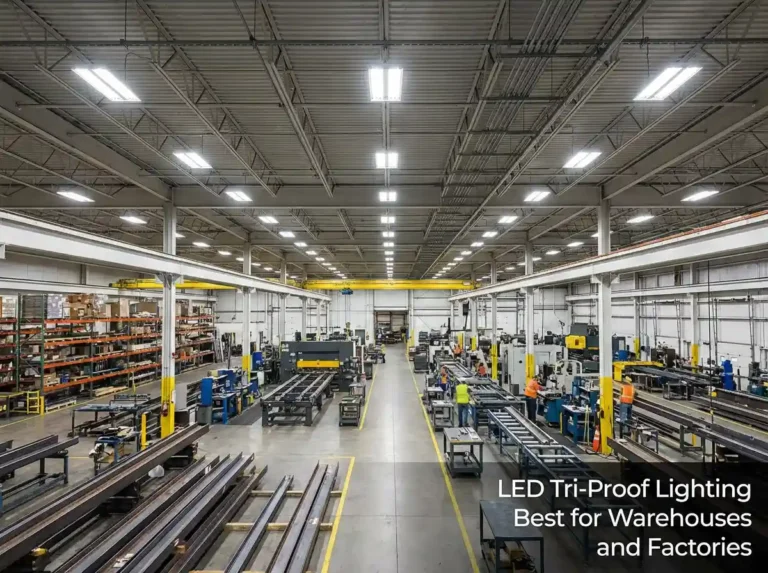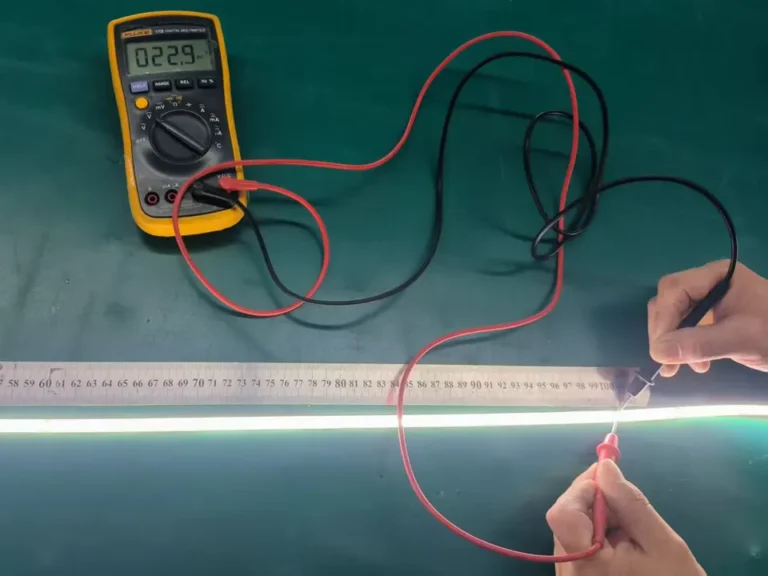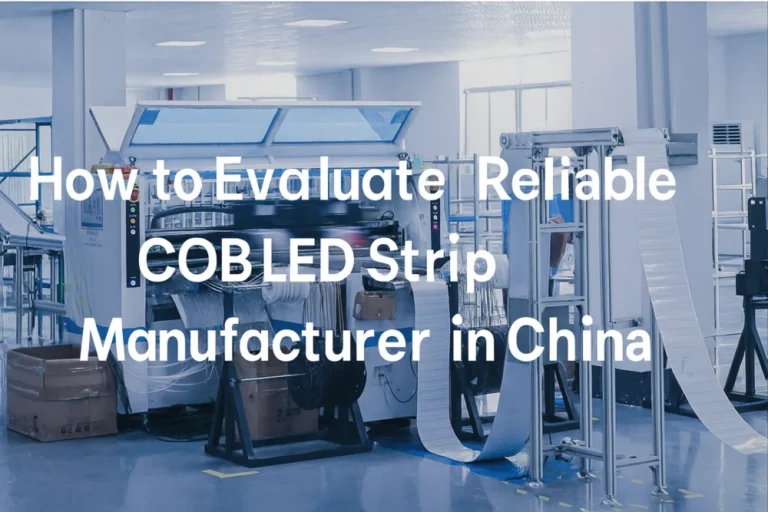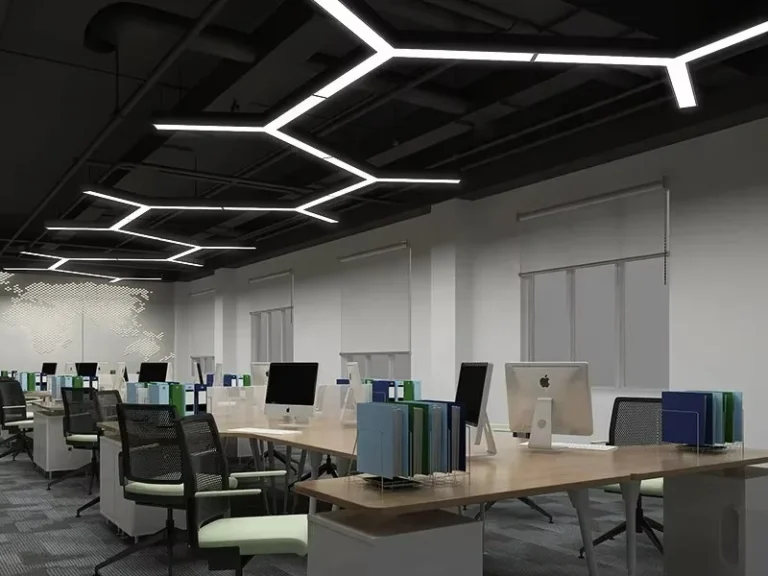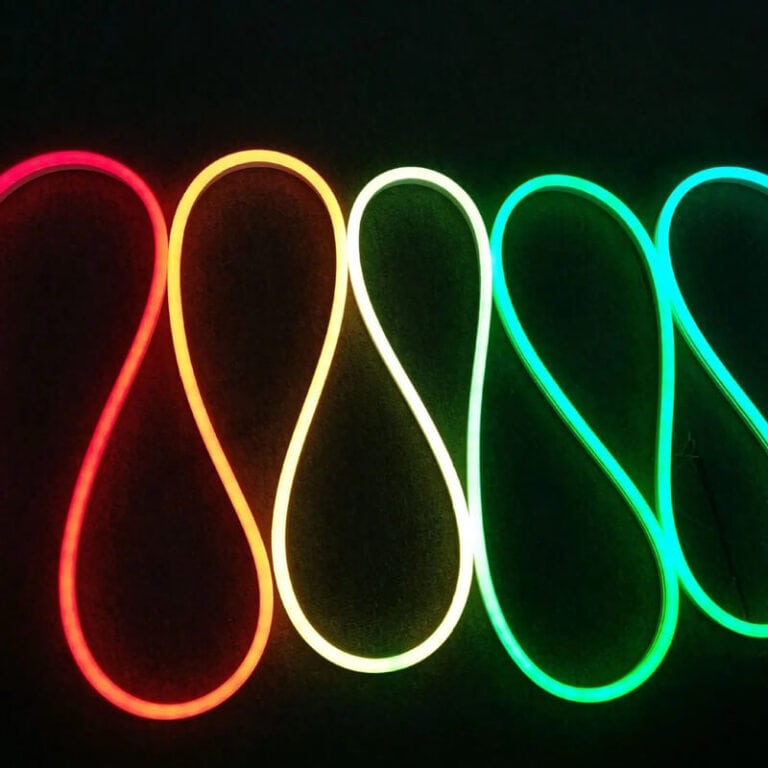W komercyjnym oświetleniu i projektowaniu domu, światła liniowe LED są szeroko popularne ze względu na ich elegancki design i równomierny rozkład światła. Jednak zaniedbanie jednolitego odblaski (UGR) może prowadzić do zmęczenia wzroku, a nawet zagrożeń bezpieczeństwa. Możemy osiągnąć komfortowe doświadczenie „widzenia światła bez widzenia źródła światła” poprzez naukowy wybór odpowiedniego oświetlenia.
Zgodnie z międzynarodowymi standardami, różne scenariusze mają wyraźne wymagania dla UGR. Biura i sale lekcyjne zwykle wymagają UGR≤19, podczas gdy niektóre ekskluzywne sale wystawowe i szpitale mają wyższe wymagania dla UGR, co wymaga UGR≤16. Dlatego UGR stał się ważnym czynnikiem, którego nie można zignorować przy zakupie oświetlenia liniowego LED.
Czy diody liniowe LED mogą osiągnąć UGR mniejszy niż 19?
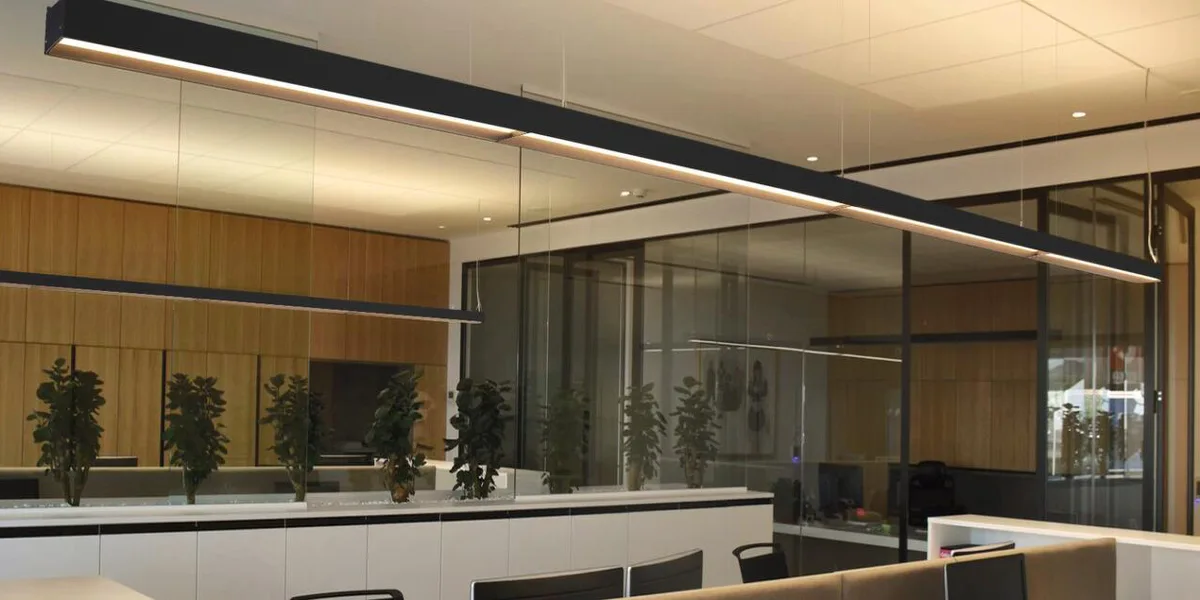
Tak, diody liniowe LED może osiągnąć UGR poniżej 19. Ujednolicony wskaźnik odblasków (UGR) jest kluczowym parametrem do pomiaru efektu olśnienia oświetlenia. Zdrowe środowiska oświetleniowe, takie jak biura, wymagają UGR poniżej 19, aby zapewnić komfort wizualny. Na przykład liniowe światła LED zaprojektowane specjalnie dla niskiego olśnienia mogą ustabilizować wartość UGR poniżej 19 dzięki mikrostrukturalnym materiałom optycznym, które są zgodne ze standardami oświetlenia budynków.
Jednak jako bezpośrednie źródło światła, światła liniowe mogą stanowić ryzyko olśnienia, jeśli są niewłaściwie zaprojektowane. Jak pokazano na rzeczywistych danych pomiarowych poniżej, ich wartości UGR mogą osiągnąć 22, przekraczając zalecaną górną granicę CIE, co prowadzi do dyskomfortu, takiego jak częste skurcze źrenic i bóle głowy. Dlatego przy wyborze produktów zaleca się priorytetowe traktowanie tych, które są wyraźnie oznaczone jako spełniające wymagania UGR.
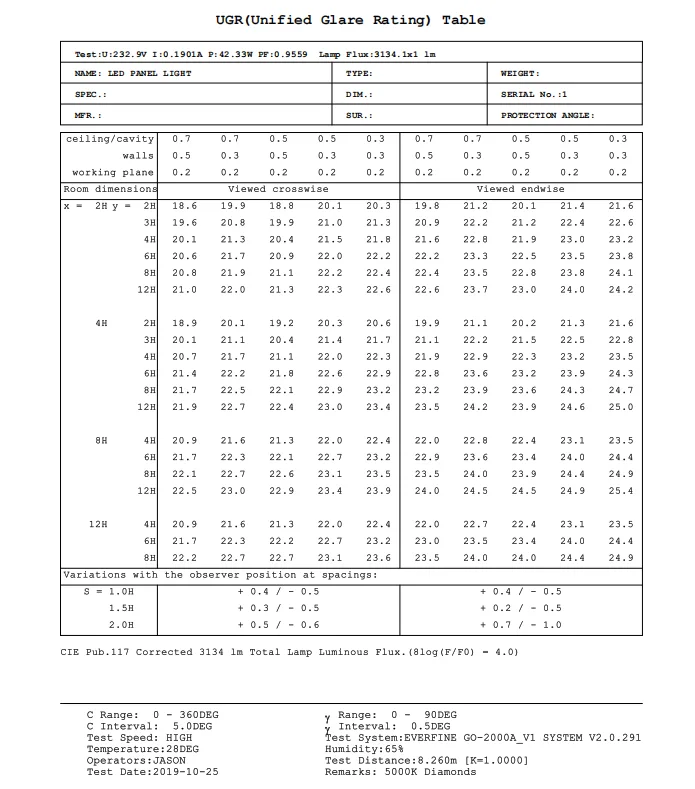
Dlaczego ocena olśnienia (UGR) świateł liniowych powinna być mniejsza niż 19?
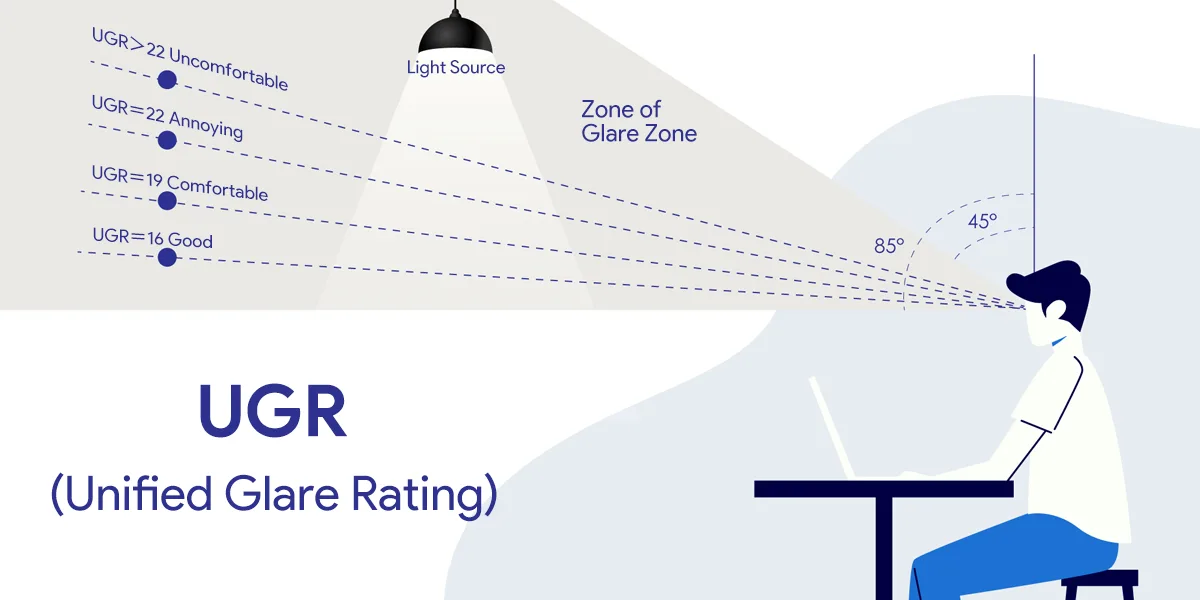
UGR (Uniform Glare Rating) to uznany na całym świecie standard oceny poziomu olśnienia w pomieszczeniach liniowych. Im niższa wartość UGR, tym słabsze odblaski i wyższy komfort wizualny. Na wartość UGR wpływa wiele czynników, w tym jasność źródła światła, położenie i poziom oświetlenia otoczenia.
Gdy UGR przekracza 19, źrenice często się dostosowują, co prowadzi do zmęczenia wzroku. Długotrwałe narażenie może powodować uszkodzenie siatkówki, pogorszenie widzenia i zwiększone ryzyko zaćmy. W samych tylko Chinach, gdzie ponad 601 TP3T nastolatków cierpi na krótkowzroczność, zanieczyszczenie olśnienia zostało zidentyfikowane jako jeden z głównych czynników przyczyniających się do tego.
Obecne standardy wymagają, aby wartości UGR w zdrowych środowiskach oświetleniowych były poniżej 19. Wymóg, aby UGR był mniejszy niż 19, opiera się przede wszystkim na następujących przyczynach:
- Zapewnienie komfortu wizualnego: Wartość UGR wynosząca 19 oznacza próg między umiarkowanym a znaczącym olśnieniem. Gdy UGR ≥ 19, uczucie rażącego światła znacznie wzrasta, potencjalnie powodując zmęczenie wzroku lub dyskomfort. Jednak gdy UGR < 19, odblaski pozostają w akceptowalnym zakresie, co czyni go odpowiednim dla środowisk, takich jak biura i sale lekcyjne, w których wymagany jest długotrwały nacisk.
- Dostosowanie do wymagań w miejscu pracy: W pomieszczeniach biurowych i innych środowiskach wymagających precyzyjnych zadań wizualnych, standardowy UGR ≤ 19 równoważy natężenie oświetlenia i komfort, zapobiegając zakłóceniu olśnienia w wydajności pracy. Na przykład norma GB50034-2013 wyraźnie przewiduje, że górna granica UGR dla ogólnych powierzchni biurowych wynosi 19, symulując komfortowe wrażenia z naturalnego środowiska oświetlenia.
- Rozróżnianie scenariuszy aplikacji: Stopniowa konstrukcja wartości UGR uwzględnia poziomy tolerancji różnych lokalizacji — UGR < 19 nadaje się do środowisk o dużym popycie (takim jak biura), podczas gdy UGR ≥ 19, który powoduje zauważalne odblaski, jest zalecany tylko w obiektach przemysłowych lub sklepach, w których wymagania dotyczące komfortu wizualnego są niższe.
Jak oceniana jest wartość UGR?
Komfortowe ocenianie wartości UGR (ocena jednolitego odblasku) zostało jasno określone przez międzynarodowe standardy. Konkretne progi komfortu i odpowiednie scenariusze są następujące:
Kiedy ugr < 13, światło jest miękkie, a ludzkie oko nie może dostrzec olśnienia. Nadaje się do przestrzeni o bardzo wysokich wymaganiach wizualnych, takich jak galerie sztuki i wysokiej klasy rezydencje.
Kiedy UGR < 16, mieści się w zakresie komfortu, z lekkim odblaskiem, który nie upośledza zadań wizualnych. Jest to zalecany standard dla sal lekcyjnych, czytelni i innych środowisk wymagających precyzyjnej pracy. Na przykład, panele panelowe chroniące oczy w salach lekcyjnych muszą kontrolować UGR ≤ 16, aby chronić wizję nastolatków.
Wartość UGR i ocenianie stanu ludzkiej percepcji stanu
| Zakres UGR | Percepcja człowieka | Obowiązujące przykłady scenariuszy |
| UGR < 13 | Brak wyczuwalnego olśnienia | Szpitale, ekskluzywne sale wystawowe, instytucje specjalne |
| 13 ≤ UGR ≤ 16 | Łagodne odblaski | Szpitale, Senior Centra aktywności |
| 16 ≤ OGR < 19 | Umiarkowane odblaski, akceptowalne, ale mogą powodować zmęczenie | Biura zwykłe, sale konferencyjne |
| 19 ≤ UGR < 22 | Próg dla zauważalnego dyskomfortu | Zakłady przemysłowe, magazyny |
| UGR ≥ 22 | Intensywne odblaski, powodujące bóle głowy | Unikaj długotrwałego obłożenia ludzi |
Próg psychologiczny między komfortem a dyskomfortem wynosi UGR = 19, ale zdrowe środowisko wizualne (takie jak przestrzenie uczenia się) powinno dążyć do UGR ≤ 16.
Obowiązkowe standardy scenariuszy aplikacji:
- placówki edukacyjne: obowiązkowe UGR ≤ 19 dla sal lekcyjnych, wysokiej jakości rozwiązania oświetleniowe powinny być zoptymalizowane do ≤ 16;
- Środowiska biurowe: UGR > 19 powoduje częste skurcze źrenic prowadzące do zmęczenia wzroku; wynik kwalifikacyjny wynosi ≤ 19;
- Strony przemysłowe: UGR ≤ 22 jest dozwolone, ale w celu zmniejszenia ryzyka dla zdrowia należy stosować akcesoria przeciwoślepiające.
Zalecenia dotyczące praktyki ochrony przed olśnieniem
| mierzyć | Zasady techniczne | Efekt redukcji UGR |
| Panel dyfuzyjny mikropryzmu | Rozkłada wiązki światła o wysokiej intensywności | Zmniejsza się do ≤16 |
| Pośredni projekt oświetlenia | Unika strefy interferencji 30° wokół ludzkiego oka | Zmniejsza się o 30% |
| Materiały o niskim połysku | Zmniejsza odblaski odbicia środowiska | Optymalizuje o 2-3 punkty |
Uwaga: Pomiary UGR wymagają rozproszonego fotometru z soczewką typu rybie oko; kalibracja jest wymagana, jeśli błąd przekracza ±10%.
Wymagania UGR dotyczące oświetlenia liniowego w Europie i Stanach Zjednoczonych
Europa i Stany Zjednoczone mają jasne standardy oceniania wymagań UGR dla oświetlenia liniowego LED. Szczegółowe przepisy i punkty realizacji są następujące.
Obowiązkowe standardy klasyfikacji UGR
Podstawowe normy UE: Wszystkie oświetlenie liniowe w pomieszczeniach musi spełniać minimalny próg bezpieczeństwa UGR ≤ 19. Przekroczenie tej wartości spowoduje nieuzyskanie certyfikatu CE. Lokalizacje specjalne mają bardziej rygorystyczne wymagania: Obszary edukacji/biura: UGR musi mieć ≤16 lat, takie jak sale lekcyjne i biura na otwartym planie; Galerie sztuki/obiekty medyczne: UGR musi mieć ≤13, a struktury przeciwodblaskowe o strukturze plastra miodu muszą być używane.
Specjalne wymagania dotyczące Ameryki Północnej: Normy UL 1598 wyraźnie wymagają opraw oświetleniowych LED do kontrolowania zagrożeń fotobiologicznych (z wyłączeniem pasma o długości fali 4400-780 nm); certyfikacja Energy Star wymaga, aby oprawy oświetlenia komercyjne miały UGR ≤ 22 i muszą wskazywać poziomy światła niebieskiego (poziom zwolnienia RG0 jest priorytetem).
Specyfikacje akceptacji pomiaru UGR
| Pozycja | Normy UE | Dodatkowe wymagania północnoamerykańskie |
| Wysokość obserwacji | Siedzący 1,2 m / stojący 1,5 m | Przestrzeganie normy CIE 117-1995 |
| Sprzęt pomiarowy | Miernik luminancji pola widzenia 143° | musi przejść kalibrację fotometryczną UL |
| Korekcja jasności tła | Eliminuje bezpośrednie zakłócenia światła z opraw | Dodaje element wykrywania odbicia lustrzanego |
Porównanie standardów UGR między Europą a Ameryką Północną
| Indykator | UE | Ameryka Północna |
| Siła egzekucyjna | UGR > 19 Zakaz cyrkulacji na rynku | Certyfikat ENERGY STAR Dobrowolne egz |
| Koncentracja techniczna | Kontrola olśnienia (UGR) jako główny fokus | Bezpieczeństwo fotowoltaiczne + efektywność energetyczna Podwójna kontrola |
| Kierunek aktualizacji | Wdrożenie UGR ≤ 16 do 2025 | Wzmocnienie standardów bezpieczeństwa dla akcesoriów do akumulatorów przyciskowych (UL4200A) |
| Próg rdzenia | UGR ≤ 19 Obowiązkowy próg (wymaganie podstawowe certyfikacji CE) | Brak obowiązkowego progu na poziomie federalnym; Energy Star zaleca ≤ 22 |
| Wymagania specjalne scenariusza | Obiekty edukacyjne/medyczne UGR ≤ 13 | Dopuszczalne oświetlenie przemysłowe UGR ≤ 25 (musi spełniać normy bezpieczeństwa elektrycznego UL 1598) |
optyczny Parametr Costata
- UE: Obowiązkowe zastosowanie miernika luminancji w polu widzenia 143° w celu wyeliminowania zakłóceń z bezpośredniego światła z oprawy;
- Ameryka Północna: Musi przejść fotometryczne urządzenie do kalibracji UL i dodać wykrywanie odbicia lustrzanego.
Odniesienie do obserwacji
- UE jednolicie przyjmuje wysokość siedzącą 1,2 m/stojącą 1,5 m dla poziomu oczu;
- Ameryka Północna jest zgodna ze standardami UE, ale pozwala producentom na określenie własnych wysokości testowych (z zastrzeżeniem rejestracji).
Kraje europejskie będą wdrażać obowiązkowe wymagania dotyczące sufitów lustrzanych z zasięgiem UGR≤16 (w tym powierzchnie handlowe) od 2025 r.: Jasność powierzchni oprawy ≤2000 cd/m²; matowe klosze o współczynniku odbicia <60%.
Oprawy oświetleniowe sterowane bezprzewodowo muszą dodatkowo spełniać wymagania: Certyfikat częstotliwości radiowych FCC (47 CFR część 15) i akcesoria do baterii z ogniwami przyciskowymi muszą być zgodne z UL 4200A3.
Alert o trendach: Nowe przepisy UE w 2025 r. włączą bezpieczeństwo fotobiologiczne (RG0) do systemu oceny UGR, a Ameryka Północna jednocześnie zmodernizuje standardy kontroli światła niebieskiego UL 153.
Jak zmierzyć wartość UGR świetlówek liniowych LED?
Wartość UGR, diody liniowe LED Jest powszechnie mierzony za pomocą goniofotometru, który może pobierać dane fotometryczne i symulować obliczenia przy użyciu standardowego oprogramowania. Poniżej przedstawiono szczegółowe procedury testowania i kluczowe punkty:
Przymocuj liniową oprawę oświetleniową do obrotowego mocowania goniofotometru. Obracając oprawę lub reflektor, przechwyć dane o rozkładzie natężenia światła w przestrzeni 360°, generując plik fotometryczny w formacie IES zawierający parametry, takie jak strumień świetlny i rozkład natężenia światła.
Długie światła liniowe zazwyczaj należą do kategorii opraw dwuosiowo symetrycznych (np. światła panelowe), co wymaga testowania krzywych rozkładu światła dla dwóch płaszczyzn symetrycznych: płaszczyzny podłużnej (C0-C180) i płaszczyzny poprzecznej (C90-C270).
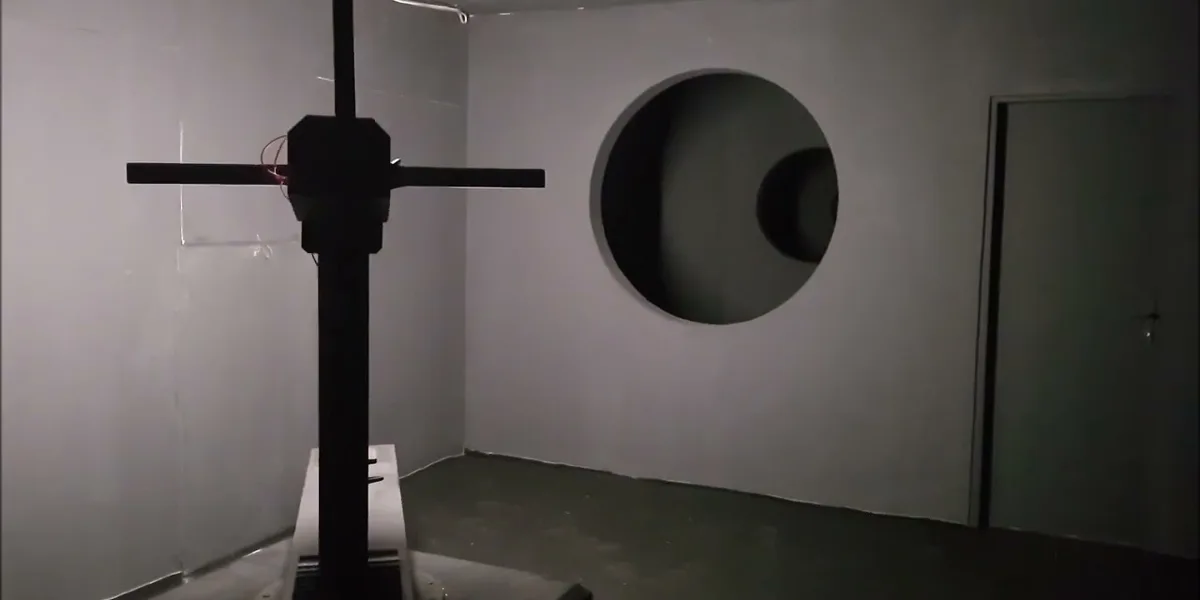
Walidacja danych
Upewnij się, że plik IES zawiera pełne informacje o rozkładzie światła (takie jak kąt krawędzi krawędzi krawędzi i rozsiewka wiązki) oraz że świetlisty kąt bryły Ω Ω oprawy mieści się w zakresie od 0,0003 do 0,1 SR, aby spełnić warunki obliczeniowe UGR.
Importowanie pliku IES do oprogramowania symulacyjnego
Podczas ładowania pliku IES liniowej oprawy oświetleniowej do profesjonalnego oprogramowania, takiego jak Dialux, potwierdź, że plik jest w pełni symetryczny lub dwuosiowo symetryczny (oprawy asymetryczne nie mogą generować tabel UGR). Jeśli plik IES nie dostosowuje się automatycznie, dostosuj symetrię za pomocą narzędzia korekty.
Skonfiguruj standardowe środowisko symulacyjne
Zgodnie ze standardami CIE 117-1995 zbuduj wirtualne pomieszczenie i zdefiniuj kluczowe parametry:
- Wymiary przestrzeni: ustawia długość i szerokość dynamicznie wg x=2h, 4h, 8h, 12h (gdzie h to wysokość od oczu obserwatora do wysokości montażu oprawy);
- odbicie: wprowadź rzeczywiste współczynniki odbicia dla sufitu i ścian (wartości domyślne: sufit 0,7, ściany 0,5);
- pozycja obserwatora: Utrzymuj poziomy wzrok, z domyślną odległością od punktu środkowego oprawy.
- Generowanie tabeli UGR i korekta: Oprogramowanie wyprowadza „tabelę oceny oświetlenia referencyjnego UGR” (tabela nieskorygowanej UGR), która reprezentuje teoretyczne wartości dla gołego źródła światła przy strumieniu świetlnym 1000 lm.
- Rzeczywista formuła korekcji UGR: Rzeczywisty UGR = wartość tabeli + 10 × log(rzeczywisty strumień światła oprawy / 1000). Na przykład, gdy strumień światła oprawy wynosi 2000 lm, dodaj 3 do wartości tabeli (10 × log₂ ≈ 3).
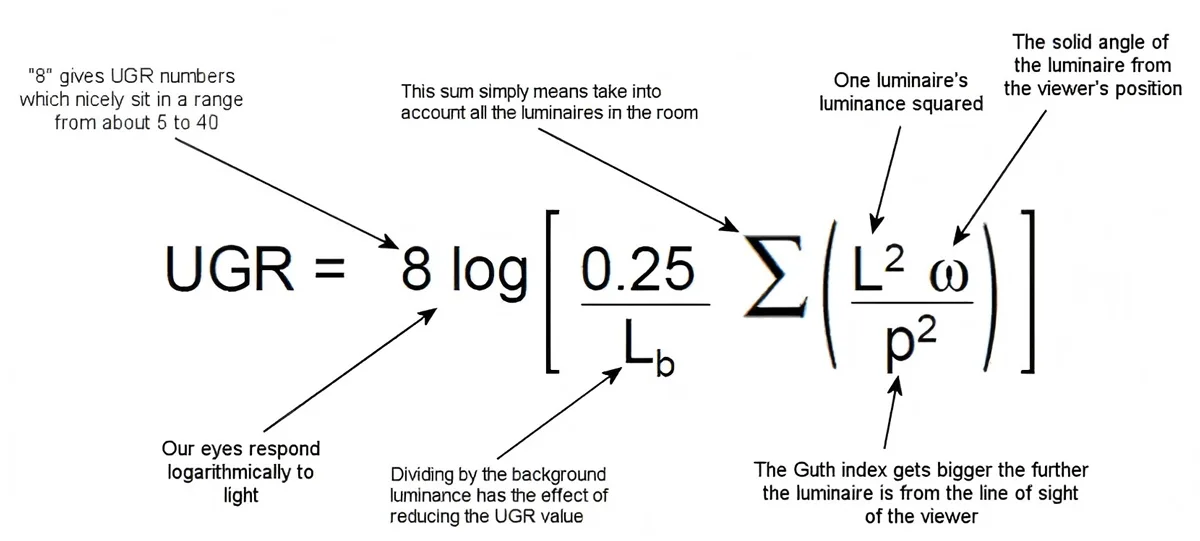
- Ograniczenia aplikacji: UGR ma zastosowanie tylko do środowisk wewnętrznych i opraw dwustronnie symetrycznych; opraw liniowych o spolaryzowanych konstrukcjach (takich jak niesymetryczne oprawy do mycia ścian) nie można bezpośrednio ocenić tą metodą.
- Różnice między zmierzonymi wynikami UGR a wynikami symulacji: Wyniki symulacji są standardowymi wartościami odniesienia dla środowiska; na rzeczywiste instalacje mają wpływ wymiary przestrzenne, materiały odblaskowe itp.
Jak skutecznie obniżyć wartość UGR świateł liniowych?
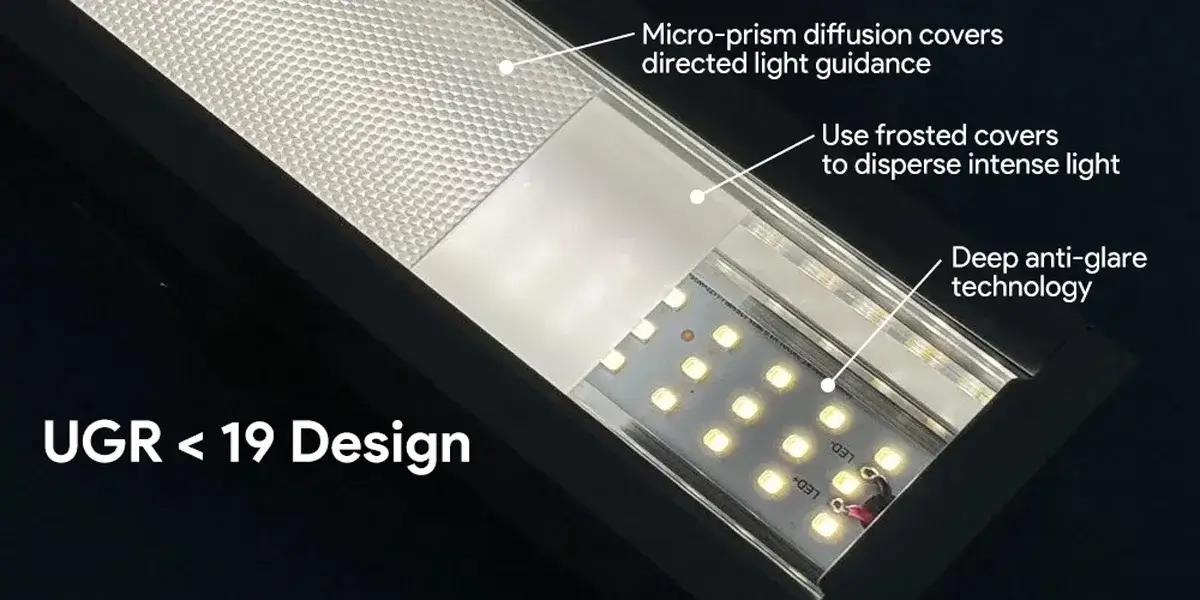
- Optymalizacja struktury optycznej: Przyjmij konstrukcję kąta olśnienia i głęboką technologię przeciwodblaskową, z kątem oślepiania ≥25 cm, aby zablokować bezpośrednie światło przed docieraniem do oczu. W przypadku ustawień przemysłowych zaleca się instalowanie świateł na wysokości ≥3,5 m i łączenie ich z odblaskami, aby zmniejszyć olśnienie.
- pole Tponowne pogodzenie Tchenologia: Użyj siatki przeciwodblaskowej o strukturze plastra miodu, aby osłabić zabłąkane odbicia, uzyskując redukcję 30% w UGR (szczególnie odpowiednią dla środowisk o wysokim odbiciu); alternatywnie użyj abażur matowych/matowych do rozpraszania intensywnego światła, zapewniając jednolitą dyfuzję światła, z odbiciem powierzchniowym <60%;
- mikro-Pruizm Dz fuzją Ppedanie: Kierowanie światła skierowane, zmniejszające UGR z 21 do 14.
- montaż i Ljut Ckontrola: Nadaj priorytet instalacji wpuszczanej, aby uniknąć odsłoniętych lamp; światła liniowe powinny być osadzone w sufitach lub ścianach (gł. osadzona ≥2 cm); gdy natynkowe, polaryzowane soczewki muszą być używane do skierowania światła w kierunku powierzchni roboczej. Lampy nie mogą być umieszczane w odległości 30° od poziomu oczu (wysokość ≥1,8 m nad ziemią jest bezpieczniejsza); sufity lustrzane muszą być połączone z matowymi abażurami, aby stłumić wtórne odbicia.
- Kontrola materiału ściany: Użyj farby matowej (odbicie <60%), unikając materiałów o wysokim współczynniku odbicia, takich jak białe ściany lub płytki; zainstaluj zakrzywione odblaskowe otwory na światło, aby przekształcić bezpośrednie światło w światło rozproszone (zmierzone UGR z 21 do 13).
- RG0-Lpoziom Bwybujała z przy Llekki Ckontrola: Użyj źródeł światła o pełnym spektrum, aby zmniejszyć stymulację fotobiologiczną;
- wytworny Dodkorz Ssystem: Dynamicznie zmniejszaj kontrast w obszarach o wysokiej jasności (musi mieć certyfikat FCC/CE).
- notatki: Przezroczyste żarówki LED są odsłoniętymi źródłami światła i mogą powodować silne odblaski; unikać gęstych układów o dużej mocy, z rozstawem lamp ≥ 1,5 razy szerokości oprawy; powierzchnie odblaskowe, takie jak meble lustrzane, biurka i ekrany, powinny być odsunięte od kąta rzutu oprawy.
- Efekt Vpodwykonawstwo: Zmierzyć skorygowaną wartość UGR za pomocą miernika luminancji pola widzenia 143°, aby zapewnić ≤19 (biuro) lub ≤13 (medyczne/edukacyjne).
Dodatkowo, aby spełnić UGR ≤19, projekty oświetleniowe muszą stosować kontrolę potrójną technologią:
- optyczny Dprojekt: Użyj mikrostrukturalnych płyt dyfuzyjnych światła, aby zmniejszyć jasność powierzchni;
- strategia: Unikaj strefy zakłóceń oka ludzkiego (w polu widzenia w górę o 30°);
- Materiał Sobranie: Użyj materiałów o niskim połysku, aby zmniejszyć odblask odblaskowy. Na przykład oświetlenie w klasie ma obowiązek posiadania UGR ≤ 19 (krajowy standard GB7793-2010), podczas gdy wysokiej klasy urządzenia (takie jak latarnie uliczne) są dalej zoptymalizowane pod kątem UGR ≤ 16.
- Optymalizacja optyczna: Zainstaluj panele dyfuzyjne mikropryzmu: UGR można zmniejszyć z 21 do 14; użyj soczewek polaryzowanych: ustawienia przemysłowe pozwalają na UGR ≤ 25, ale muszą być połączone ze ścianami o współczynniku odbicia ≤ 60%.
- Tabu instalacyjne: Ściśle zabroń umieszczania gołych lamp w poziomym polu widzenia ludzkiego oka 30°; wysokość 1,8 metra nad ziemią jest bezpieczniejsza; w lustrzanych ustawieniach sufitu należy stosować matowe klosze.
Cztery podstawowe zalety LED Light Linear Light SignLited
Wyjątkowa wydajność optyczna: Wyposażony w konstrukcję redukcji olśnienia z UGR < 19, światło jest równomiernie rozpraszane przez pryzmatyczny panel dyfuzji, uzupełniony o precyzyjny system soczewek optycznych, który skutecznie kontroluje ostrość granicy plamka świetlnego, osiągając standardy tłumienia olśnienia klasy muzealnej.
Konstrukcja konstrukcyjna klasy przemysłowej: Zbudowany z profili ze stopu aluminium klasy lotniczej i technologii nanopowłoki, ma stopień ochrony IP66, który jest w stanie wytrzymać ekstremalne warunki od -30°C do 60°C. Jego innowacyjna modułowa konstrukcja montażowa obsługuje wielowymiarową regulację od 0° do 90°, umożliwiając instalację w zakrzywionych lub nieregularnych przestrzeniach.
wytworny Ewspółsystem INTEGRACJA: Wbudowany sterownik podwójnego protokołu DALI/PWM, kompatybilny z inteligentnymi systemami sterowania. Grafenowa technologia rozpraszania ciepła zapewnia ponad 931 TP3T konwersję efektywności energetycznej, w połączeniu z żywotnością ponad 50 000 godzin, oszczędzając ponad 401 TP3T energii w porównaniu z tradycyjnymi oprawami oświetleniowymi.
zróżnicowany Vwysoki: Produkt posiada certyfikat CE i ROHS, oferując 5-letnią gwarancję. Dostosowane systemy serwisowe mogą uwzględniać wymagania dotyczące specjalnej temperatury barwowej (regulowane od 2700K do 6500K) i wskaźnika oddawania kolorów (RA ≥ 95) wymagań dla przestrzeni komercyjnych, galerii sztuki i innych scenariuszy.
Dzięki wyjątkowej wydajności optycznej, wytrzymałej konstrukcji klasy przemysłowej, inteligentnej kompatybilności sterowania i wysoce dostosowanym usługom, SignliteLed diody liniowe LED stały się idealnym wyborem dla nowoczesnego oświetlenia architektonicznego i wysokiej klasy przestrzeni komercyjnych. Niezależnie od tego, czy podejmujesz nowy projekt budowlany, czy modernizujesz oświetlenie, Signlited może zapewnić Ci bardziej wydajne, inteligentniejsze i bardziej zorientowane na projekt rozwiązania oświetleniowe.
